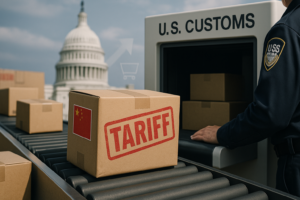As the global race to dominate artificial intelligence accelerates, the United States and China are redrawing the world’s technological map one semiconductor at a time.
Washington’s sweeping export controls on advanced chips and AI tools have reshaped the supply chains that underpin modern computing, fracturing decades of global tech integration. The restrictions, first introduced in October 2022 and expanded since, have not only curbed China’s access to cutting-edge semiconductors but also placed key U.S. allies in an increasingly delicate position.
Strategic Silence in the Netherlands
Few countries illustrate this tension more clearly than the Netherlands, home to ASML Holding NV, the world’s only manufacturer of extreme ultraviolet (EUV) lithography machines—an essential tool for producing the world’s most advanced chips. Under U.S. pressure, the Dutch government has imposed new export licensing requirements on ASML’s deep ultraviolet (DUV) systems, effectively limiting what can be shipped to China.
Publicly, Dutch officials have tread carefully, emphasizing alignment with allied security concerns while resisting full decoupling. However, behind closed doors, Dutch executives have expressed frustration at the growing compliance burden and lost Chinese market share. China accounted for roughly 29% of ASML’s sales in 2023—a share now under threat.
Taiwan’s Balancing Act
Taiwan, home to the world’s most advanced chipmaker, Taiwan Semiconductor Manufacturing Co. (TSMC), finds itself walking a geopolitical tightrope. TSMC’s dominance in producing 3nm and 5nm chips places it at the epicenter of the U.S.-China rivalry.
While the company has complied with U.S. restrictions, including halting shipments of advanced chips to Huawei, it also maintains a significant footprint in China to support legacy production. TSMC’s planned fabs in Arizona and Japan reflect a shift toward localization and political hedging. Still, executives are wary of being caught in a bifurcated world where duplication of chipmaking capacity becomes the norm rather than the exception.
South Korea’s Reluctant Realignment
South Korean giants Samsung Electronics and SK Hynix also find themselves ensnared in the tech clash. Both companies rely on China for a substantial portion of their semiconductor revenue, particularly from memory chips. While Washington has granted temporary exemptions allowing them to maintain operations in China, Seoul has voiced concern over long-term access and the prospect of a hardened tech bloc.
Korean officials have publicly supported “rules-based trade” but are privately lobbying Washington for predictability and clarity. With new investment plans in the U.S. and India, South Korean firms are seeking to diversify ties with the world’s second-largest economy.
A Fractured Future for Global Tech
The reshuffling of supply lines has broader implications for global trade. The rise of “techno-protectionism” is encouraging countries to onshore strategic capabilities, build domestic fabs, and guard intellectual property with new urgency. The Biden administration’s CHIPS and Science Act, alongside the EU’s Chips Act, marks a global pivot toward industrial policy after decades of laissez-faire globalization.
China, meanwhile, has doubled down on self-sufficiency. Its “Made in China 2025” strategy is alive in spirit if not in name, with heavy state support flowing into domestic chip startups and state-owned giants like SMIC. Though still years behind in leading-edge manufacturing, Beijing has made strides in AI algorithms and applications, fueling a sense of urgency in Washington.
Conclusion: The Cost of Competition
What once looked like a shared global project of faster chips, smarter machines, and more integrated systems is increasingly becoming a strategic battleground. With multinationals forced to pick sides, and governments hardening their tech borders, the AI arms race is less about innovation alone and more about who controls the future architecture of power.
For now, the winners are those able to navigate this fractured landscape without falling into it.













